Calculation of the diameter of a gas pipeline: example of calculation and features of laying a gas network
Today the cheapest and most accessible type of fuel is gas. However, routes carrying explosive fuel into the home should be laid with extreme caution and comply with all standards.Therefore, owners of country houses need to clearly know how to calculate the diameter of a gas pipeline and what to pay attention to during installation.
The article we presented describes in detail how to lay pipes and connect them to the house. We will tell you what documents you will need to obtain and how to control the installation of the system. The information we offer for review is based on building regulations.
The content of the article:
- Why gasify your house?
- Main types of gas pipelines
- Norms and standards for pipe laying
- Installation methods and their features
- What documents will be needed?
- How to calculate the diameter of a gas pipeline?
- Selection of pipes and fasteners
- Procedure for laying a gas pipeline
- Conclusions and useful video on the topic
Why gasify your house?
The main reason is cheapness and convenience. The difficult economic situation in the country is forcing owners of private houses to look for the most affordable option for heating the building. Therefore, it is not at all surprising that over time, cottage owners come to the conclusion that they need gasify the building.
Yes, of course, you can heat your home with electricity. But such a solution is quite expensive, especially if you need to heat several hundred square meters. And the vagaries of nature in the form of strong winds or hurricanes can break the cables and you will have to sit for who knows how long without heating, food or hot water.
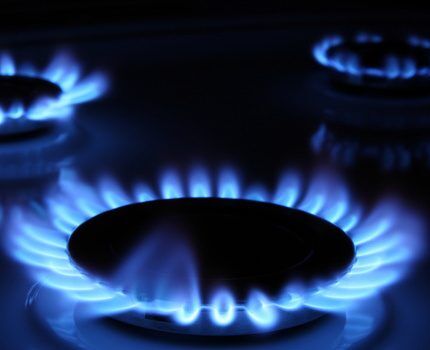
Another alternative to gas is the old and proven method - heating using a fireplace or brick oven. The main disadvantage of this solution is that storing firewood or coal will lead to dirt.
In addition, it will be necessary to allocate additional square meters for their storage. Therefore, blue fuel will occupy a leading position for many years to come, but the question gas pipeline design will be relevant for connecting the private sector for a very long time.
Main types of gas pipelines
There are three types of highways. The first is a low pressure gas pipeline. For such a system, the maximum permissible pressure is 5 kPa. Most often, this type is laid in small settlements. It is also used for gas supply to medical institutions, residential buildings, children's and public buildings.
For the second type - medium pressure line - the fuel flow can be supplied with a force of up to 0.3 MPa. The scope of application of this type is limited to the provision of gas to quarterly and regional regulatory stations.
As for the high-pressure line, it is intended for supplying fuel to large industrial enterprises. For owners of private houses, such a solution is irrelevant. After all, gas is supplied to the cottage using a pipe, the pressure in which does not exceed 5 kPa.
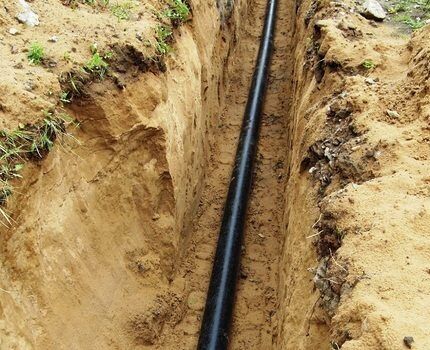
It is written in detail about pressure parameters and the classification of gas pipeline networks according to its value in the article, the contents of which we recommend that you familiarize yourself with.
Norms and standards for pipe laying
Gas enters residential buildings through inlets coming from fuel distribution stations. As a rule, they are installed on the ground floor and then laid along the staircases. The pipe that is supplied to a residential building must be manufactured using a seamless method, and its wall thickness is at least 3.5 mm.
At supplying a highway to a private house it should be located at a distance of at least 15 cm from the water supply and heating pipes. In the case of telephone or electrical cables, this value increases to half a meter.
The gas pipeline is predominantly made of steel. Therefore, to prevent pipe corrosion, it is coated with a special insulating material. Thanks to this, the structure does not come into contact with wet soil.
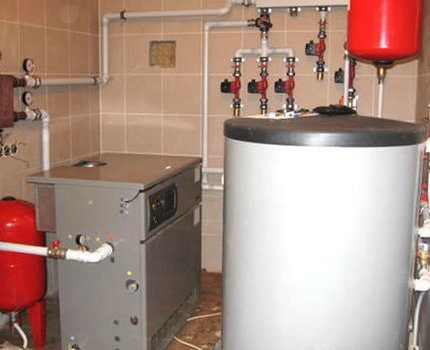
Installation methods and their features
A gas pipeline can be laid using various methods. This is underground, onshore or underwater installation. In buildings, network installation can be done hidden or open.
Each variety has its own advantages and disadvantages. Therefore, before giving preference to any of the varieties, it is necessary to understand in detail all its features.
Advantages and disadvantages of the underground method
Until recently, the underground method was predominantly used when installing a gas pipeline. In this case, the pipes are laid in pre-dug trenches.Moreover, their depth must correspond exactly to the value specified in the project. Today this solution is used less and less.
The drop in demand is due to the high cost of this type of gasket. In addition, digging holes where the pipes will be laid will take quite a lot of time. Currently, engineers prefer the trenchless method. Its peculiarity lies in the use of equipment that can perform horizontal directional drilling.
Thanks to this, the cost of laying is reduced threefold, and the time required to organize the highway is reduced by at least two times.
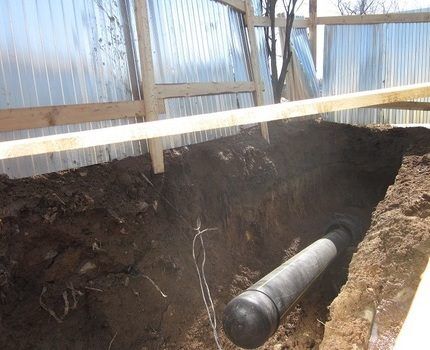
Underground method drilling using HDD equipment frees you from the need to restore green spaces. Therefore, this kind of solution can be called as environmentally friendly as possible. Installation using this method involves drilling a pilot well, which is subsequently expanded to the required dimensions.
Next, the walls are strengthened using a special solution. To protect the pipeline from underground water flows and excessive mechanical loads, it is placed in a protective case. The final stage is pulling the pipes through the well.
External organization of the gas pipeline
The external method is used most often. In this case, the gas pipeline is usually stretched across the cottage yard. In this case, the structure must be protected from unauthorized persons. For this purpose, the pipes are located at a considerable height.
Particular attention should be paid to fixation.Fastenings must be as strong and reliable as possible to minimize the risk of falling and, as a result, damage to the gas pipe.
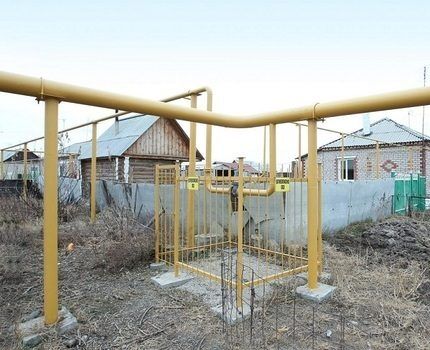
Ground and overhead installation
Compared to the underground installation method, the above-ground installation will cost almost half as much. But in this case, special attention must be paid to protecting the structure from environmental influences and mechanical damage.
For example, the pipe must be insulated so that precipitation does not fall on it and temperature changes are not noticeable. Moreover, the type of protection is selected depending on the climatic conditions of the region.
To prevent unauthorized connection to the highway, it is necessary to take care of security. After all, due to the fact that the pipe lies on special supports on the ground, third parties can easily access it. Therefore, unlike underground installation, this solution is less reliable.
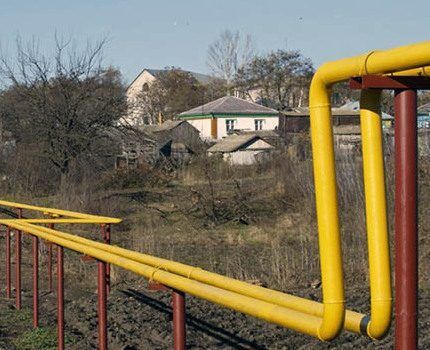
Which method of installing a gas pipeline is better?
It is necessary to give preference to one or another solution depending on the climate of the region where the work will be carried out, building density and soil characteristics. Accordingly, there is simply no clear answer.
To decide which installation method is best to choose, you should consider the following recommendations:
- If the soil on the site is highly corrosive, then the most correct solution would be to install the gas pipeline using the ground method.
- When the pipeline crosses a road, a combined option is economically viable. That is, in the area of the roadbed the pipe should be located above the ground, and in a suburban area it should be laid in trenches.
- In the case of laying a pipeline through adjacent areas, it is recommended to choose the above-ground (open) method.
- When a gas pipeline passes through an area with an extensive power transmission line system, a hidden installation of the pipeline would be a reasonable solution.
The installation method directly affects the material from which the pipeline should be made. The question related to which pipe and fittings to use in this or that case will be discussed further.
What documents will be needed?
Before proceeding directly with the installation, you will have to start collecting the necessary papers. To do this as quickly as possible, you must immediately prepare a passport, as well as documentation that confirms ownership of the plot and the house located on it.
The next step is to submit an application to the appropriate service. It expresses a desire to gasify the house. Employees will issue a form listing all technical specifications.
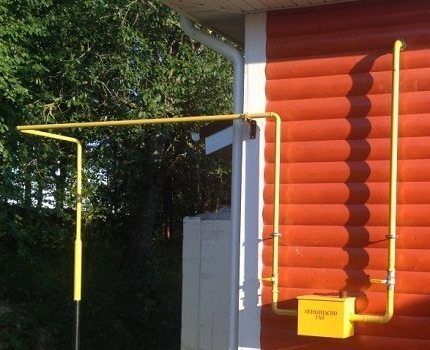
According to the project, a gas network is being installed. Sometimes pipes are laid through neighbors' properties. In this case, it is necessary to request written permission from them to carry out this type of work.
In addition to the papers listed above, you will also need to obtain the following documents:
- act of putting gas-powered equipment into operation;
- agreement on the preparation of technical documentation and work;
- permission to supply natural gas and pay for this service;
- document on installation of equipment and gasification of the house.
A chimney inspection will also be required. After this, specialists will issue a corresponding certificate. The last document - permission to gasify a private house - is issued by a local architectural and planning company.
How to calculate the diameter of a gas pipeline?
When drawing up a project, special attention is paid to the diameter of the pipe. This will be done by the designer using complex formulas or a program.
In order not to bother yourself with various formulas, a good choice would be to use one of the specialized programs. Fortunately, the Internet is full of such software. Using calculators is as easy as pie—you just need to fill in the fields with the appropriate information.

Standard prices for connecting a private household to main gas are given here. Owners of suburban areas should know “how much” gasification will cost.
Selection of pipes and fasteners
Since the pipeline with blue fuel is an object of increased danger, all fittings used must have the necessary quality certificates. Otherwise, the commission conducting the final inspection will not allow the house with such pipes to be gasified.
Nuances of choosing material
The pipe material is selected depending on the method of laying the pipeline. Products made of polyethylene and steel are in greatest demand.The main advantage of the latter variety is its versatility. After all, steel pipes can be used for both underground and external installation. But such a solution will cost more.
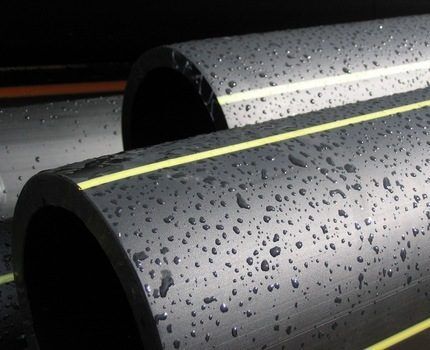
As for the fastening elements, for installation you will need angles, couplings, tees, crosses, plugs and adapters. As a rule, they are made of cast iron, steel or polyethylene.
Also, do not hesitate to install the meter. After all, it will significantly reduce costs.
Advantages of polyethylene pipes
First of all, such fittings do not rust over time. Therefore, it allows you to save on pipeline maintenance and repair. Thanks to a special production technology, polyethylene products have an absolutely smooth inner surface. As a result, the fuel flow rate is not slowed down in any way.
One of the main advantages of polymer pipes is their safety. There will be no stray currents in them that could cause the gas to explode. So in case of underground installation there is no need to use a special expensive case.
If we compare the weight of a steel pipe and a polymer pipe, the latter type is as much as 7 times lighter. This property makes it possible to significantly reduce the cost of construction, because there is no need to involve equipment with increased load capacity.
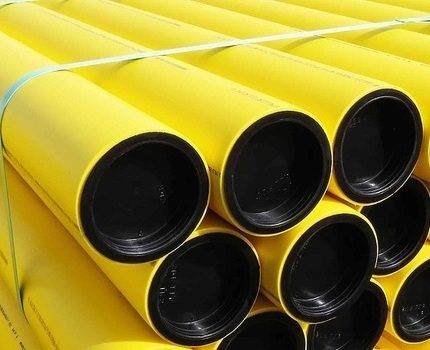
Pipes made of polyethylene, due to their flexibility, have earned the respect of specialists.Due to this, installation using the horizontal directional drilling method will not cause any difficulties or problems. This solution is especially relevant when the well has an uneven shape or any obstacles were discovered during its creation.
When should you stop using polymer?
In some cases, polyethylene products will be a poor choice. Limiting conditions include a situation where the ground temperature in winter can drop below -15 degrees.
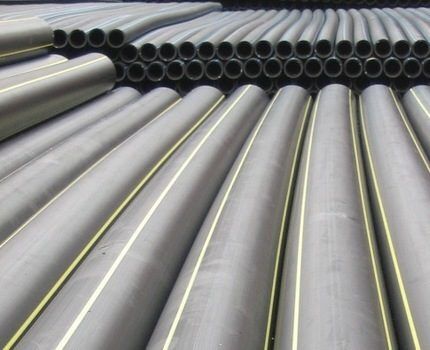
The use of polymer reinforcement is also prohibited in the following situations:
- the pipeline will supply liquefied hydrocarbons;
- an open installation method was chosen;
- if the gas pipeline passes over any obstacles (railway or highway).
After all the necessary products have been purchased and the documents have been collected, you can understand the features of laying a line with blue fuel.
Procedure for laying a gas pipeline
Despite the fact that pipe installation should be carried out exclusively by professionals with the necessary qualifications, every owner of a private house should familiarize himself in detail with the procedure for carrying out the work. This will avoid troubles and unplanned financial expenses.
Installation of the riser and preparation of the premises
If a private house is gasified for the purpose of organizing heating, then you need to take care of the arrangement of the premises. The room with all the equipment should be separate and have fairly good ventilation. After all, natural gas is not only explosive, but also toxic to the human body.
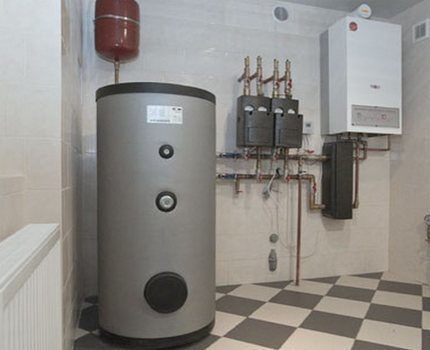
As for the dimensions, the ceiling height in the room should be at least 2.2 m. For a kitchen where a stove with two burners will be installed, an area of 8 m will be sufficient2, and for a four-burner model - 15 m2.
If equipment with a power of more than 30 kW will be used to heat the house, then the boiler room must be moved outside the house and be a separate building.
Gas is supplied to the cottage through an input device, which is a hole above the foundation. It is equipped with a special case through which the pipe passes. One end of it is connected to the riser, and the other is part of the internal gas supply system.
The riser is installed exactly vertically and the structure must be removed from the wall at a distance of at least 15 cm. The reinforcement can be secured using special hooks.
Subtleties of internal system construction
When installing a pipeline in a wall, all its parts must be passed through sleeves. In this case, the entire structure must be coated with oil paint. The free space present between the pipe and the sleeve is filled with tarred tow and bitumen.
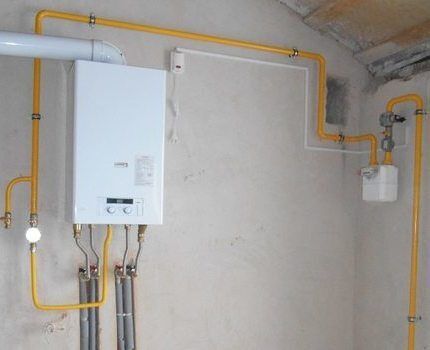
Each of the units is assembled at the bottom, and at the height only the fastening of the preparatory components is carried out. If the diameter of the pipes does not exceed 4 cm, then they can be secured using clamps or hooks.For all others, it is recommended to use brackets or hangers.
Welding, assembly and acceptance rules
Will introduce you to the specifics of organizing autonomous gas heating next article, which examines in detail the options for heating units. Will be useful for independent craftsmen boiler wiring diagramsgiven in the material we recommend.
All components of the pipeline are connected to each other by welding. In this case, the seam must be of high quality and reliable. To achieve this, you must first align the end of the pipe and strip about 1 cm from each side.
As for assembling threaded connections, you need to use a special technique for this. First, the joint is processed using whitewash. The next step is to wind long-fiber flax or special tape. Only after this can the threaded connection be tightened.
As soon as the craftsmen finish the work, a commission should come to the house. It is carried out gas pipeline pressure testing and checking the quality of installation. Moreover, the owner is required to be instructed on the rules for using the gas pipeline. Employees will also tell you how to properly operate equipment that consumes blue fuel.
Conclusions and useful video on the topic
Video #1. All about gasification of a private home:
Video #2. Main stages of installation:
Laying a gas main to a private home is a labor-intensive and responsible process. After all, the impeccability of delivery and the safety of residents directly depend on the quality of the work. Therefore, it is better to entrust the calculations and installation itself to highly qualified and experienced employees.
Please leave comments in the block below. Tell us about how you or your neighbor's house was connected to the main gas supply.Ask questions about controversial issues, post photos of the process of laying pipes or connecting equipment.




Our gas is quite cheap, so we decided to take the plunge once and install a gas pipeline to our house. Before this, we used gas cylinders, but this is quite expensive, considering that they need to be filled approximately once a month at a gas station. We hired a team of specialists, they calculated everything correctly and did it quickly, and we were satisfied. Now the problem of filling the cylinder is a thing of the past.
I would like to ask where the phrase came from: “The pipe that is supplied to a residential building must be made using a seamless method, and its wall thickness is at least 3.5 mm.” As far as I know very well, according to building codes, pre-insulated electric-welded pipes are suitable.
Good afternoon. We will check the information and make adjustments if necessary!